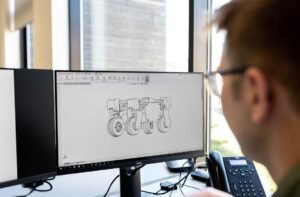Language Processing Area of the Brain
The human brain is a remarkable organ, responsible for our thoughts, feelings, and actions. One area of the brain that plays a crucial role in our ability to understand and produce language is the language processing area. This intricate network of neurons allows us to communicate and process the complex structures of language.
Key Takeaways:
- The language processing area of the brain is responsible for our ability to understand and produce language.
- It is comprised of interconnected regions that work together to process different aspects of language.
- Damage to the language processing area can result in language impairments and difficulties.
- Neuroplasticity allows the brain to adapt and reorganize after injury to the language processing area.
The Language Processing Area: An Intricate Network
The language processing area consists of several interconnected regions, each with its own specific function. These regions include the Broca’s area, responsible for speech production, and the Wernicke’s area, responsible for language comprehension. Other regions, such as the superior temporal gyrus, also play a role in language processing.
Research has shown that the language processing area is not strictly limited to these specific regions, but rather involves a network of brain areas working together. This network includes the arcuate fasciculus, a bundle of nerve fibers connecting Broca’s and Wernicke’s areas, and the angular gyrus, which integrates visual information with language processing.
Language processing in the brain is like a symphony orchestrated by different regions, each playing its own role.
The Impact of Damage
Damage to the language processing areas of the brain can result in language impairments known as aphasias. Broca’s aphasia, caused by damage to the frontal lobe, is characterized by difficulty in speech production, while Wernicke’s aphasia, caused by damage to the posterior superior temporal gyrus, affects language comprehension.
- Individuals with Broca’s aphasia may struggle to form complete sentences, relying on short and simple phrases.
- Those with Wernicke’s aphasia may produce sentences that are grammatically correct but lack coherent meaning.
Our ability to communicate can be profoundly affected when the language processing area of the brain is damaged.
Neuroplasticity: The Brain’s Adaptability
The brain has an incredible ability to adapt and reorganize itself, a phenomenon known as neuroplasticity. This means that, although damage to the language processing area can result in language difficulties, the brain can often compensate by redistributing language functions to other regions.
Research has shown that intensive speech therapy and language rehabilitation can activate dormant neural pathways and improve language abilities in individuals with language impairments. Through practice and targeted interventions, the brain can rewire itself to overcome language challenges.
Neuroplasticity highlights the brain’s remarkable ability to overcome adversity and regain lost language functions.
Tables and Data
| Region | Function |
|---|---|
| Broca’s area | Speech production |
| Wernicke’s area | Language comprehension |
| Arcuate fasciculus | Connects Broca’s and Wernicke’s areas |
| Angular gyrus | Integrates visual information with language processing |
| Aphasia Type | Location of Damage | Characteristics |
|---|---|---|
| Broca’s aphasia | Frontal lobe | Difficulty in speech production |
| Wernicke’s aphasia | Posterior superior temporal gyrus | Impaired language comprehension |
| Therapy | Outcome |
|---|---|
| Intensive speech therapy | Activation of dormant neural pathways |
| Language rehabilitation | Improved language abilities |
The Fascinating Brain
The language processing area of the brain is a captivating system that enables us to communicate and understand the complexities of language. Its interconnected regions and networks work harmoniously to process speech, comprehension, and production. Although damage to this area can result in language impairments, the brain’s incredible adaptability and neuroplasticity offer hope for rehabilitation and recovery.

Common Misconceptions
Misconception 1: Language processing occurs in a single area of the brain
Contrary to popular belief, language processing does not happen in a single area of the brain. Instead, it involves the coordination of multiple brain regions working together. While certain areas like Broca’s area and Wernicke’s area are known to play important roles in language production and comprehension, they are just a part of a larger network of interconnected regions.
- Language processing involves multiple brain regions.
- Broca’s area is responsible for language production.
- Wernicke’s area is involved in language comprehension.
Misconception 2: The left hemisphere is solely responsible for language processing
Another misconception is that language processing is strictly localized in the left hemisphere of the brain. While it is true that the left hemisphere typically plays a dominant role in language functions for most individuals, the right hemisphere also contributes to certain aspects of language processing. For example, the right hemisphere is involved in processing the prosody and emotional aspects of language.
- The left hemisphere is typically dominant for language processing.
- The right hemisphere contributes to prosody and emotional aspects of language.
- Both hemispheres work together to process language.
Misconception 3: Language processing areas are fixed and unchangeable
Many people believe that the language processing areas of the brain are fixed and unchangeable. However, research has shown that the brain is highly adaptable and can reorganize its functions in response to language learning or brain damage. This phenomenon, known as brain plasticity, allows other regions of the brain to compensate and take over language processing functions.
- The brain is highly adaptable and can reorganize language processing functions.
- Brain plasticity allows compensation for language learning and brain damage.
- Other brain regions can take over language processing functions.
Misconception 4: Language processing is a purely cognitive process
While language processing involves cognitive processes, it is not purely cognitive in nature. It is also influenced by various factors such as the sensorimotor system and social interaction. For example, gestures and body movements can contribute to language comprehension, and social context plays a crucial role in the interpretation of language. Therefore, language processing is a complex interaction of cognitive, sensorimotor, and social processes.
- Language processing involves cognitive, sensorimotor, and social processes.
- Gestures and body movements contribute to language comprehension.
- Social context plays a crucial role in language interpretation.
Misconception 5: Language processing is the same for all individuals
Lastly, it is a misconception that language processing is identical for all individuals. While there are common patterns and structures in language processing, there can be significant individual differences. Factors such as language proficiency, age, cognitive abilities, and cultural background can influence the way an individual’s brain processes language. These differences highlight the uniqueness of each individual’s language processing abilities.
- Language processing can vary among individuals.
- Language proficiency, age, and cognitive abilities influence language processing.
- Cultural background affects the way the brain processes language.

Language Processing Area of the Brain
In this article, we explore the fascinating world of language processing and its connection to the brain. The brain is an intricate organ responsible for many complex functions, including the ability to understand and produce language. Through years of scientific research, we have gained valuable insights into the specific areas of the brain that play a crucial role in this process. Below, we present ten tables showcasing various points, data, and other elements related to the language processing area of the brain.
The Wernicke’s Area: Language Comprehension
Located in the left hemisphere of the brain, the Wernicke’s area is primarily responsible for language comprehension, enabling us to understand spoken and written words.
Broca’s Area: Language Production
Broca’s area, found in the frontal lobe of the left hemisphere, is crucial for language production. It coordinates the muscles involved in speech and allows us to articulate words fluently.
Heschl’s Gyrus: Auditory Processing
Situated in the temporal lobe, Heschl’s gyrus specializes in auditory processing, receiving and analyzing sound signals before relaying them to the language processing areas of the brain.
Angular Gyrus: Reading and Writing
The angular gyrus, located at the intersection of the temporal, parietal, and occipital lobes, plays a crucial role in reading and writing abilities, allowing us to decipher written text and express our thoughts through writing.
Arcuate Fasciculus: Neural Connection
The arcuate fasciculus is a bundle of nerve fibers connecting the Wernicke’s and Broca’s areas. It serves as a neural pathway for the transfer of information required for comprehensive language processing.
Supramarginal Gyrus: Phonological Processing
Involved in phonological processing, the supramarginal gyrus assists in recognizing and distinguishing various speech sounds, contributing to our understanding of language.
Inferior Frontal Gyrus: Grammar and Syntax
The inferior frontal gyrus, located within the frontal lobe, is associated with grammar and syntax. It helps us understand and construct grammatically correct sentences.
Superior Temporal Gyrus: Semantic Processing
The superior temporal gyrus plays a vital role in semantic processing, enabling us to extract meaning from words, phrases, and sentences, ultimately facilitating comprehension.
Posterior Superior Temporal Gyrus: Speech Perception
The posterior superior temporal gyrus is involved in speech perception, allowing us to identify different speech sounds, tones, and accents, enhancing our ability to communicate effectively.
Orbitofrontal Cortex: Emotional Aspects of Language
The orbitofrontal cortex, located behind the eyes, is associated with the emotional aspects of language. It helps us convey and interpret emotions through speech, adding depth to our communication.
Conclusion
Language processing is a remarkable phenomenon intricately intertwined with various regions of the brain. The Wernicke’s and Broca’s areas, along with other specialized regions, work together to comprehend, produce, and express language. Understanding the neural underpinnings of language processing not only provides us with insights into human communication but also aids in diagnosing and treating language-related disorders. As we continue to uncover the intricacies of the brain, our comprehension of language and its neural basis deepens, enhancing our appreciation for the beauty and complexity of our ability to communicate.
Frequently Asked Questions
What is language processing?
Language processing refers to the way our brain comprehends and produces language, enabling us to communicate and understand the meaning of words, sentences, and conversations.
What is the language processing area of the brain?
The language processing area of the brain, also known as the language center or language areas, is a group of interconnected brain regions responsible for language-related functions such as speech production, comprehension, and reading.
Which brain regions are involved in language processing?
Several brain regions are involved in language processing, including the Broca’s area, Wernicke’s area, angular gyrus, and the primary auditory cortex. These regions work together to facilitate different aspects of language processing.
What is the role of Broca’s area in language processing?
Broca’s area, located in the frontal lobe of the dominant hemisphere, plays a crucial role in speech production and articulation. It is responsible for coordinating the movements of the mouth, tongue, and vocal cords necessary for fluent speech.
What is the role of Wernicke’s area in language processing?
Wernicke’s area, situated in the posterior section of the dominant hemisphere’s temporal lobe, is involved in language comprehension. It enables us to understand and interpret spoken and written language.
What is the function of the angular gyrus in language processing?
The angular gyrus, located at the junction of the parietal, temporal, and occipital lobes, integrates visual information with language comprehension. It aids in reading comprehension and helps us associate written words with their meanings.
How does the primary auditory cortex contribute to language processing?
The primary auditory cortex, situated in the temporal lobe, is responsible for processing auditory information. It plays a vital role in speech perception by decoding and analyzing the sounds and tones of spoken language.
Can language processing abilities vary among individuals?
Yes, language processing abilities can vary among individuals. Factors such as genetic predisposition, language exposure during early development, and neurological conditions can influence an individual’s language processing skills.
Can language processing be disrupted due to brain injuries or disorders?
Yes, brain injuries or disorders can disrupt language processing. Conditions such as aphasia, dyslexia, and specific language impairments can affect various aspects of language comprehension and production.
How can language processing in the brain be studied?
Researchers study language processing in the brain using various techniques such as functional magnetic resonance imaging (fMRI), electroencephalography (EEG), and lesion studies. These methods help identify which brain regions are active during specific language tasks and provide insights into how language is processed.




